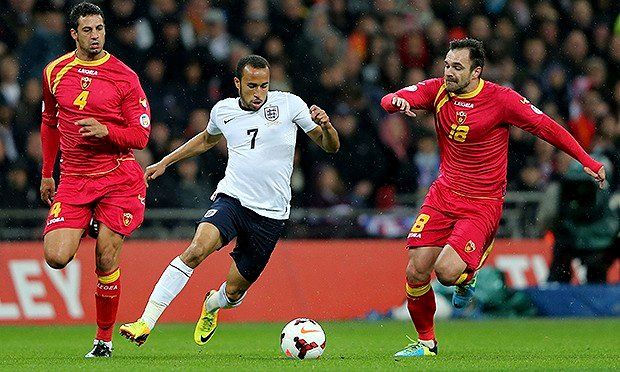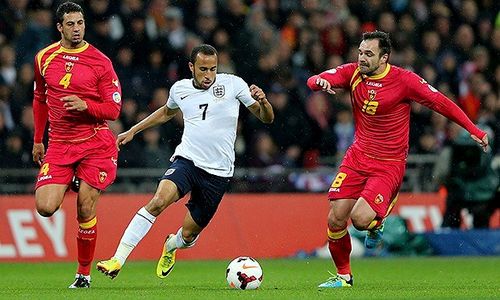
Jovetic gives Rooney a lesson in the No.10 role, as England triumph despite Lampard-Gerrard hassles

Andros Townsend impressed on his debut
Roy Hodgson’s initial period as England manager saw him get a lot of stick for rigidly fixating on playing with 2 banks of 4 players. Roy later changed this shape to a more contemporary midfield trio, though most of these games did not feature Wayne Rooney, so the likes of Jack Wilshere joined the Lampard- Gerrard duo.
Hodgson’s team sheet against Montenegro at Wembley yesterday was a sharp reminder of his stubborn tactics from the past, and England were only saved by a fantastic display by debutant Townsend and a bizarre own goal by Boskovic.
Roy left Carrick, Wilshere and Phil Jones on the bench, and went with Gerrard and Lampard starting in central midfield. On paper the shape would seem to be a cautious 4-2-3-1 with Rooney sitting at the tip of the triangle, but on the field it turned out to be a rather static and languid looking 4-4-1-1.
When on the ball, England had 4 players in the attacking roles: Sturridge, Rooney, Welbeck and Townsend. This would have made perfect sense if both of the two central midfielders were used to sit deeper and stay alert for Montenegro’s counter-attacks. But neither Lampard nor Gerrard were able to take up good enough positions nor were they able to track the runs of the spirited Montenegrin attackers in the final third. The visitors at Wembley were crucially missing Vucinic, Basa and a few key players, so they ran out of steam despite Stevan Jovetic’s encouraging performance.
Steven Gerrard has been established as a deep lying playmaker at Liverpool for the past 2 seasons, and has been used in a similar role by Hodgson. The only difference being that the crucial role Lucas takes up next to StevieG at Liverpool has been given to Lampard by Roy, rather than the more adept Carrick.
Against Moldova and Ukraine, Gerrard’s role as the CDM was complimented well by the presence of the duo Wilshere and Lampard in a 4-1-2-3. But on Friday night, the midfield duo of Lampard and Gerrard meant that there was only one short-passing option for the player in the center, and the safer option was the more regularly played long ball.
Montenegro were quick to identify this flaw, as both of their attacking players did not press either of the English Center backs, but rather positioned themselves around either Lampard or Gerrard who took up a position in the middle. This stifled Cahill and Jagielka’s style to play the short pass into the midfield or come out of the defense with the ball, and they rather settled for the ball out to the fullbacks. Now this is where England prospered over their opponents, as Hodgson’s men had a completely diverse, though equally potent threat on either flank.
Andros Townsend on the right was able to link up well with his Spurs’ teammate Walker at Right back. But the young winger’s reluctance to shoot after cutting in from the flank meant that much of England’s initial threat was crowded out by Montenegro in the middle. Moreover Townsend’s style sees him pick up the ball in quite deep positions on the right and then dribble past opponents while drifting in.
This rarely allowed any sort of overlap to take place on the now empty right flank. There were only on a couple of occasions where Walker and Rooney were able to take advantage of Townsend’s now empty flank, though in the second half Townsend started to put in many more crosses from the touchlines.
Everything England created came from the flanks, either from Townsend or Baines, and neither of the 2 in-from strikers Sturridge or Rooney was able to shine through the center. The very debate regarding Rooney’s role as a No.10 comes into play here as the Manchester United man was again seen sitting in high positions next to the opposition center backs when England lost the ball.
A stark contrast to this was Montenegro’s No.10 Stevan Jovetic, who despite carrying a niggle, put in an extremely energetic stint at the tip of Montenegro’s midfield. Jovetic was a constant menace for Lampard and Gerrard on the ball, and it was the sole reason why Lampard often took to pick out long balls rather than finding either Gerrard or Rooney next to him. Jovetic was often found defending deep while tracking Lampard’s runs and the new Manchester City forward was also a constant presence in Montenegro’s menacing attacks.
In fact, it was not until Roy brought on Carrick for Lampard did the English setup look comfortable and stable. Right from his introduction, Carrick was able to enforce his interceptions and tackles deep in England’s half and now England had a source of short passes into Steven Gerrard in the center. Until this point, all of these passes were just long punts into the flanks. Carrick’s presence now encouraged the likes of Danny Sturridge to now fall back deeper and thus find much more space to operate in. The chances that now fell to Welbeck and Rooney should have been finished off easily.
Though Townsend was England’s shining light here, ironically he will lose his place if Walcott returns into form. Tom Cleverley’s pre-match injury did not cause much of a flutter earlier in the day, but the young midfielder’s energetic presence was indeed missing in the center. Cleverley’s knack of distributing the ball quickly to the wings and shifting himself laterally was exactly what this static midfield needed. Some touches in this regard were added by Wilshere late on, though these were more due to Montenegro’s late surge.
This English squad is nowhere near perfect, and will be having another tough night against Poland on Tuesday if they play a similar setup in midfield. Though this defense would not be troubled much on the night, Roy needs to sort out the marking and positioning of the midfield duo on the night.